Microeconomics: Analysis of Trade Policies and Taxation Impacts
VerifiedAdded on 2020/05/28
|12
|1819
|54
Homework Assignment
AI Summary
This microeconomics assignment analyzes the impact of trade policies and taxation on market outcomes. The assignment begins by examining the effects of an export subsidy on beef exports between Australia and Canada, considering the implications for producer surplus, consumer surplus, and government revenue. It then explores the effects of import quotas on beef, analyzing their impact on consumer and producer surplus, and deadweight loss. Furthermore, the assignment delves into trade protection policies, discussing their rationale and impact on industries, diversification, and government revenue. The final part investigates the effects of taxation on a commodity with inelastic demand, Alcopops, assessing the effectiveness of the tax and discussing alternative policies to reduce demand. Diagrams are used to illustrate the concepts.
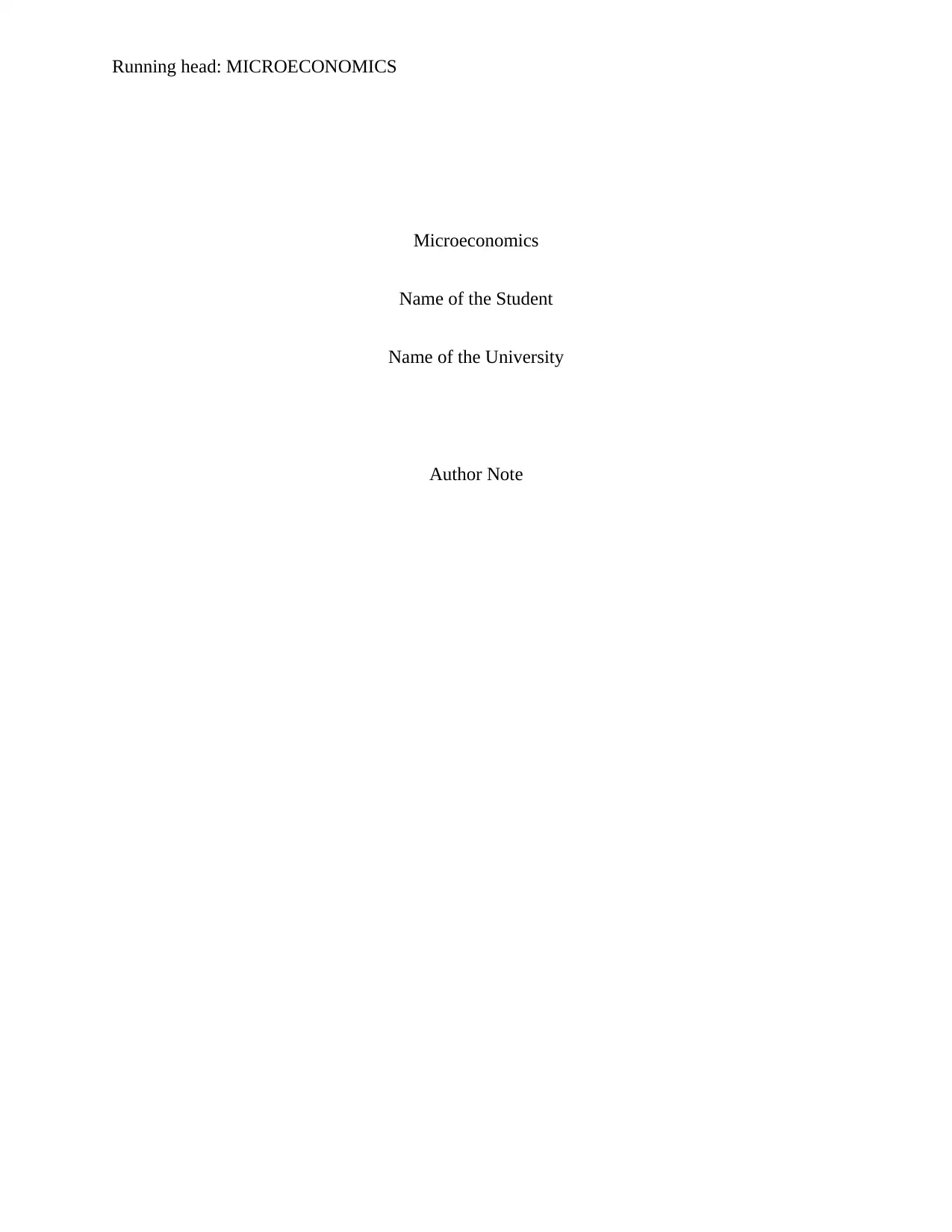
Running head: MICROECONOMICS
Microeconomics
Name of the Student
Name of the University
Author Note
Microeconomics
Name of the Student
Name of the University
Author Note
Paraphrase This Document
Need a fresh take? Get an instant paraphrase of this document with our AI Paraphraser
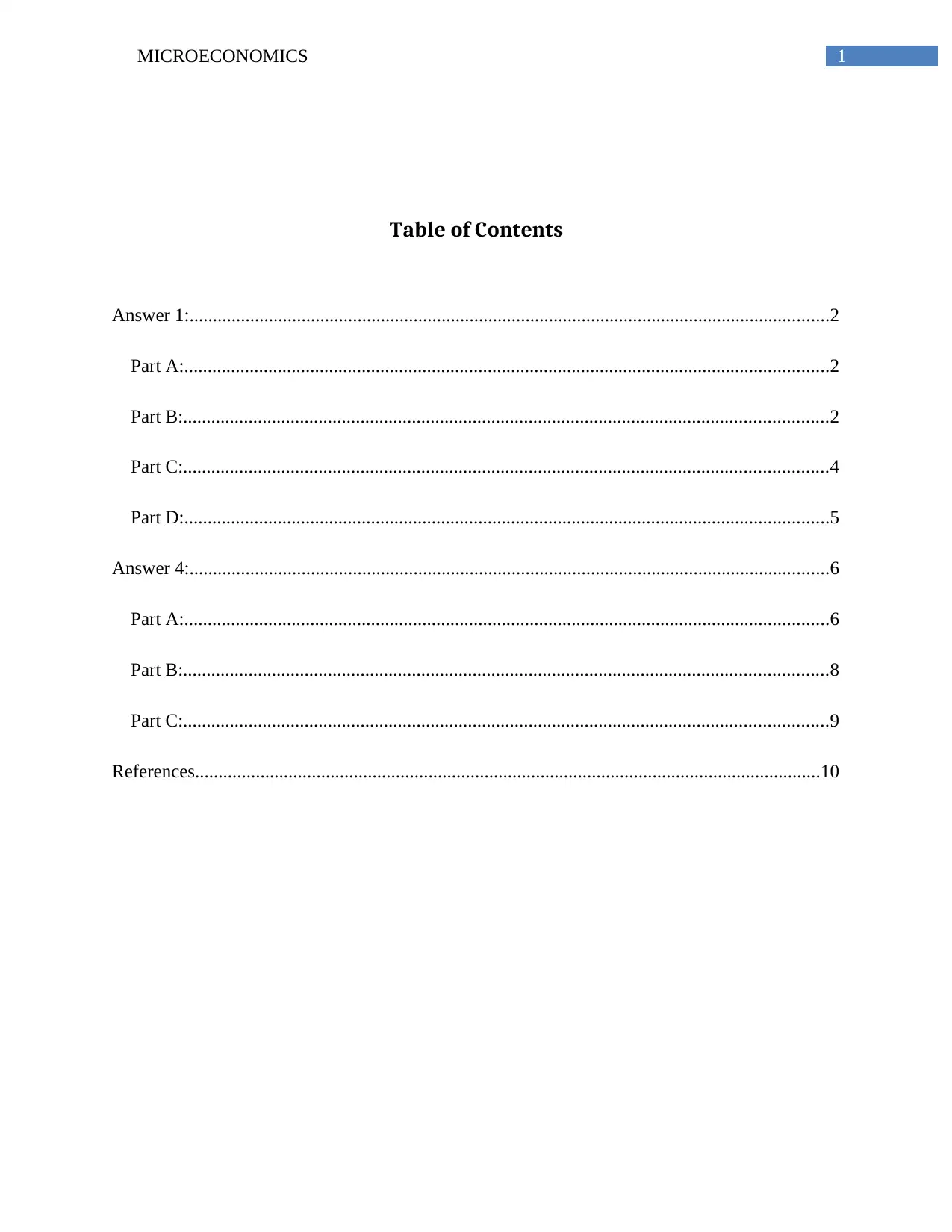
1MICROECONOMICS
Table of Contents
Answer 1:.........................................................................................................................................2
Part A:..........................................................................................................................................2
Part B:..........................................................................................................................................2
Part C:..........................................................................................................................................4
Part D:..........................................................................................................................................5
Answer 4:.........................................................................................................................................6
Part A:..........................................................................................................................................6
Part B:..........................................................................................................................................8
Part C:..........................................................................................................................................9
References......................................................................................................................................10
Table of Contents
Answer 1:.........................................................................................................................................2
Part A:..........................................................................................................................................2
Part B:..........................................................................................................................................2
Part C:..........................................................................................................................................4
Part D:..........................................................................................................................................5
Answer 4:.........................................................................................................................................6
Part A:..........................................................................................................................................6
Part B:..........................................................................................................................................8
Part C:..........................................................................................................................................9
References......................................................................................................................................10
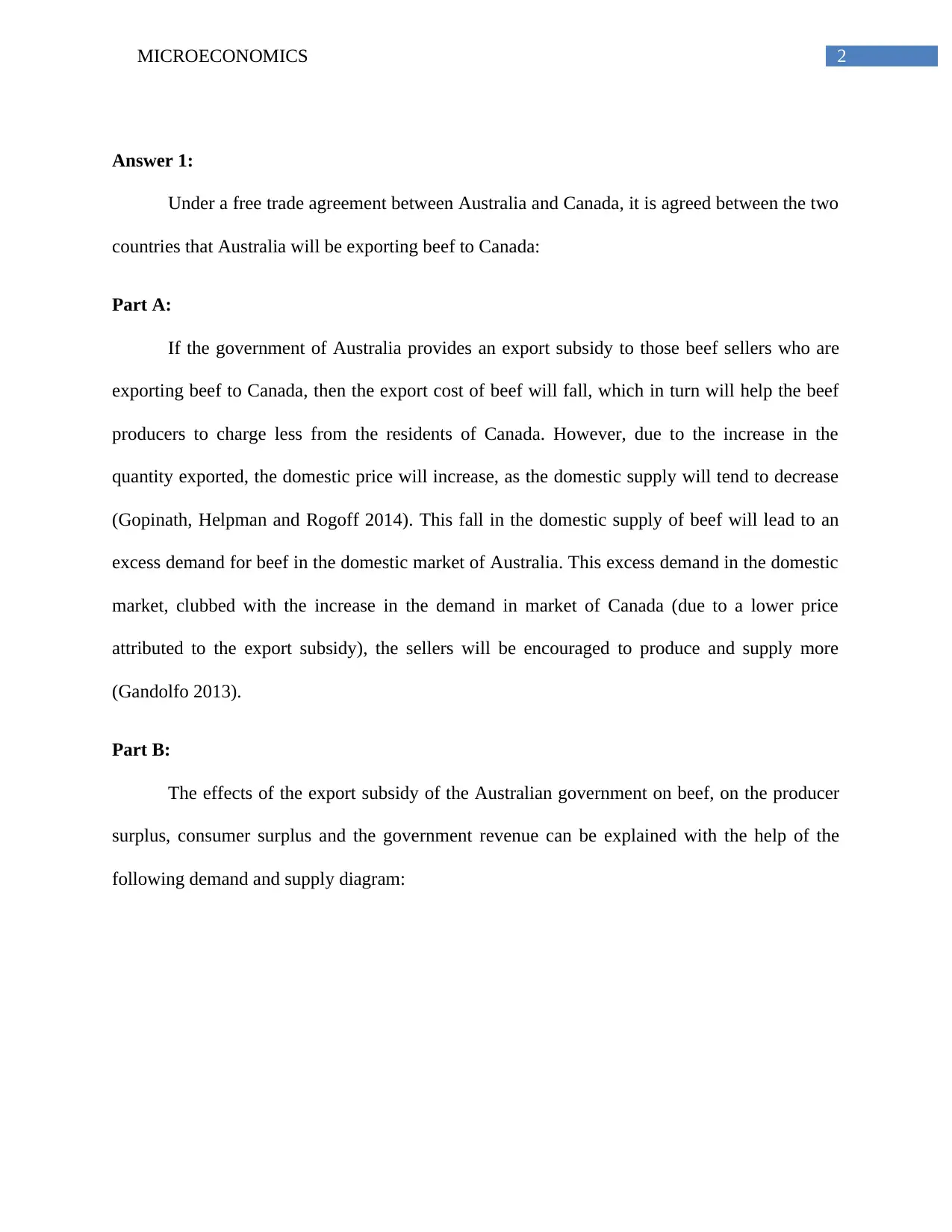
2MICROECONOMICS
Answer 1:
Under a free trade agreement between Australia and Canada, it is agreed between the two
countries that Australia will be exporting beef to Canada:
Part A:
If the government of Australia provides an export subsidy to those beef sellers who are
exporting beef to Canada, then the export cost of beef will fall, which in turn will help the beef
producers to charge less from the residents of Canada. However, due to the increase in the
quantity exported, the domestic price will increase, as the domestic supply will tend to decrease
(Gopinath, Helpman and Rogoff 2014). This fall in the domestic supply of beef will lead to an
excess demand for beef in the domestic market of Australia. This excess demand in the domestic
market, clubbed with the increase in the demand in market of Canada (due to a lower price
attributed to the export subsidy), the sellers will be encouraged to produce and supply more
(Gandolfo 2013).
Part B:
The effects of the export subsidy of the Australian government on beef, on the producer
surplus, consumer surplus and the government revenue can be explained with the help of the
following demand and supply diagram:
Answer 1:
Under a free trade agreement between Australia and Canada, it is agreed between the two
countries that Australia will be exporting beef to Canada:
Part A:
If the government of Australia provides an export subsidy to those beef sellers who are
exporting beef to Canada, then the export cost of beef will fall, which in turn will help the beef
producers to charge less from the residents of Canada. However, due to the increase in the
quantity exported, the domestic price will increase, as the domestic supply will tend to decrease
(Gopinath, Helpman and Rogoff 2014). This fall in the domestic supply of beef will lead to an
excess demand for beef in the domestic market of Australia. This excess demand in the domestic
market, clubbed with the increase in the demand in market of Canada (due to a lower price
attributed to the export subsidy), the sellers will be encouraged to produce and supply more
(Gandolfo 2013).
Part B:
The effects of the export subsidy of the Australian government on beef, on the producer
surplus, consumer surplus and the government revenue can be explained with the help of the
following demand and supply diagram:
⊘ This is a preview!⊘
Do you want full access?
Subscribe today to unlock all pages.

Trusted by 1+ million students worldwide
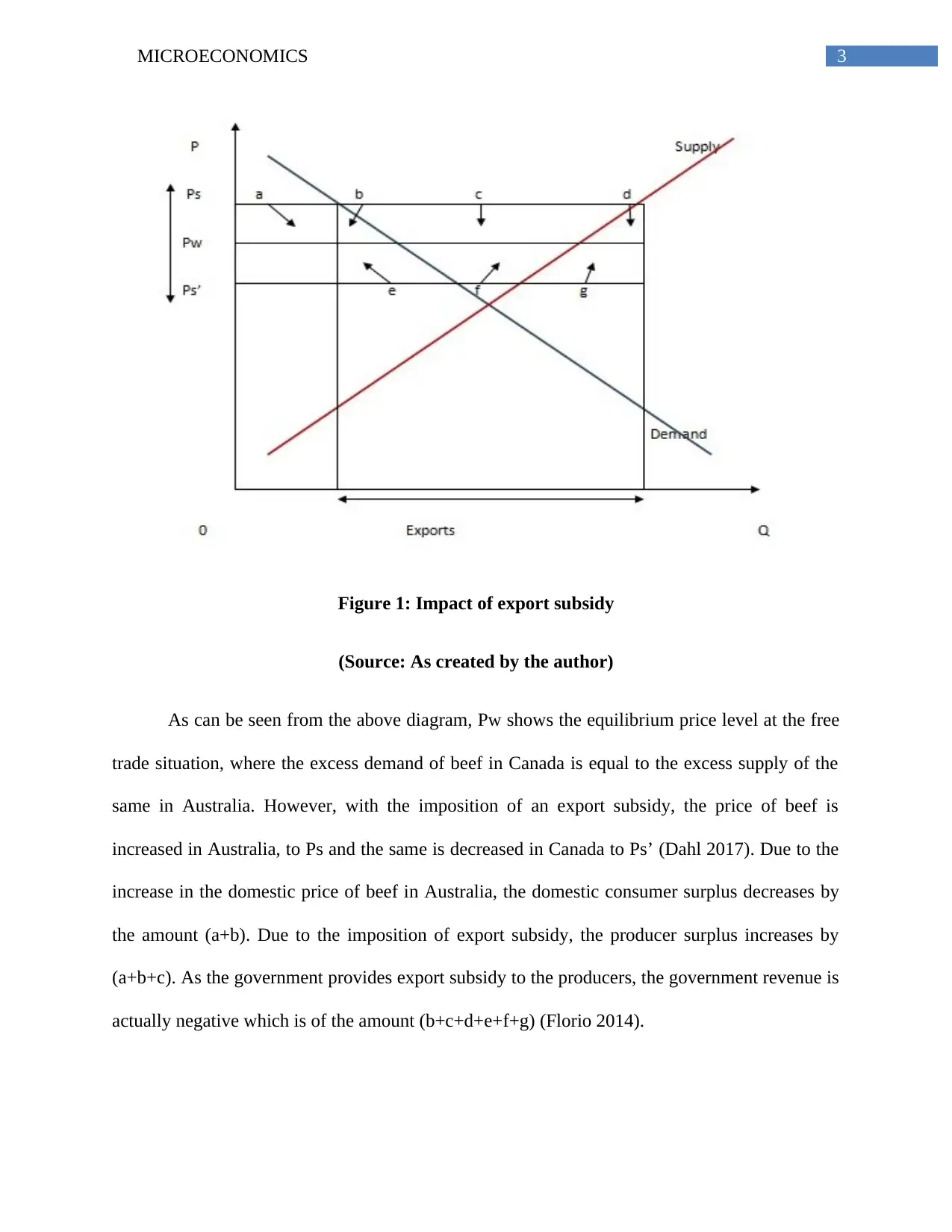
3MICROECONOMICS
Figure 1: Impact of export subsidy
(Source: As created by the author)
As can be seen from the above diagram, Pw shows the equilibrium price level at the free
trade situation, where the excess demand of beef in Canada is equal to the excess supply of the
same in Australia. However, with the imposition of an export subsidy, the price of beef is
increased in Australia, to Ps and the same is decreased in Canada to Ps’ (Dahl 2017). Due to the
increase in the domestic price of beef in Australia, the domestic consumer surplus decreases by
the amount (a+b). Due to the imposition of export subsidy, the producer surplus increases by
(a+b+c). As the government provides export subsidy to the producers, the government revenue is
actually negative which is of the amount (b+c+d+e+f+g) (Florio 2014).
Figure 1: Impact of export subsidy
(Source: As created by the author)
As can be seen from the above diagram, Pw shows the equilibrium price level at the free
trade situation, where the excess demand of beef in Canada is equal to the excess supply of the
same in Australia. However, with the imposition of an export subsidy, the price of beef is
increased in Australia, to Ps and the same is decreased in Canada to Ps’ (Dahl 2017). Due to the
increase in the domestic price of beef in Australia, the domestic consumer surplus decreases by
the amount (a+b). Due to the imposition of export subsidy, the producer surplus increases by
(a+b+c). As the government provides export subsidy to the producers, the government revenue is
actually negative which is of the amount (b+c+d+e+f+g) (Florio 2014).
Paraphrase This Document
Need a fresh take? Get an instant paraphrase of this document with our AI Paraphraser
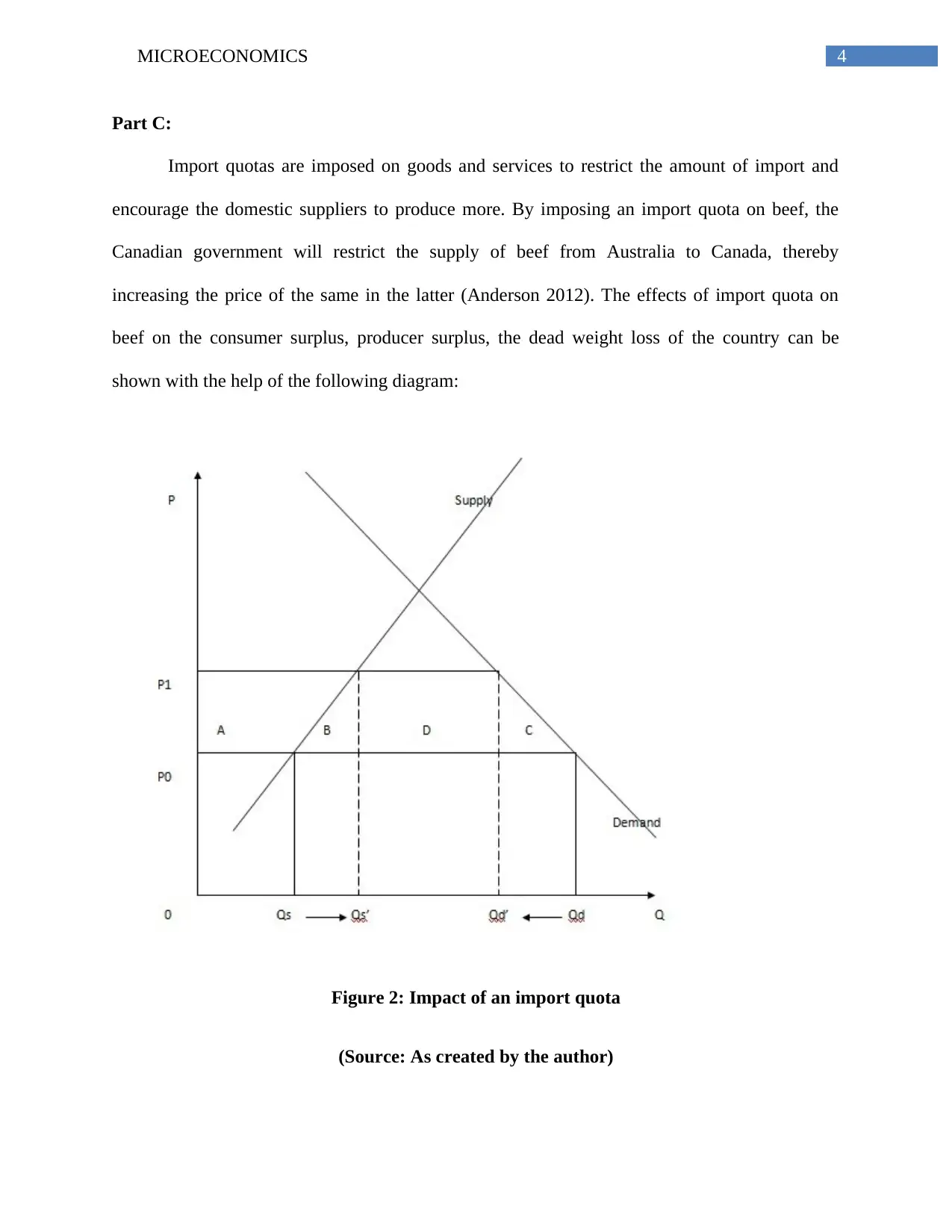
4MICROECONOMICS
Part C:
Import quotas are imposed on goods and services to restrict the amount of import and
encourage the domestic suppliers to produce more. By imposing an import quota on beef, the
Canadian government will restrict the supply of beef from Australia to Canada, thereby
increasing the price of the same in the latter (Anderson 2012). The effects of import quota on
beef on the consumer surplus, producer surplus, the dead weight loss of the country can be
shown with the help of the following diagram:
Figure 2: Impact of an import quota
(Source: As created by the author)
Part C:
Import quotas are imposed on goods and services to restrict the amount of import and
encourage the domestic suppliers to produce more. By imposing an import quota on beef, the
Canadian government will restrict the supply of beef from Australia to Canada, thereby
increasing the price of the same in the latter (Anderson 2012). The effects of import quota on
beef on the consumer surplus, producer surplus, the dead weight loss of the country can be
shown with the help of the following diagram:
Figure 2: Impact of an import quota
(Source: As created by the author)
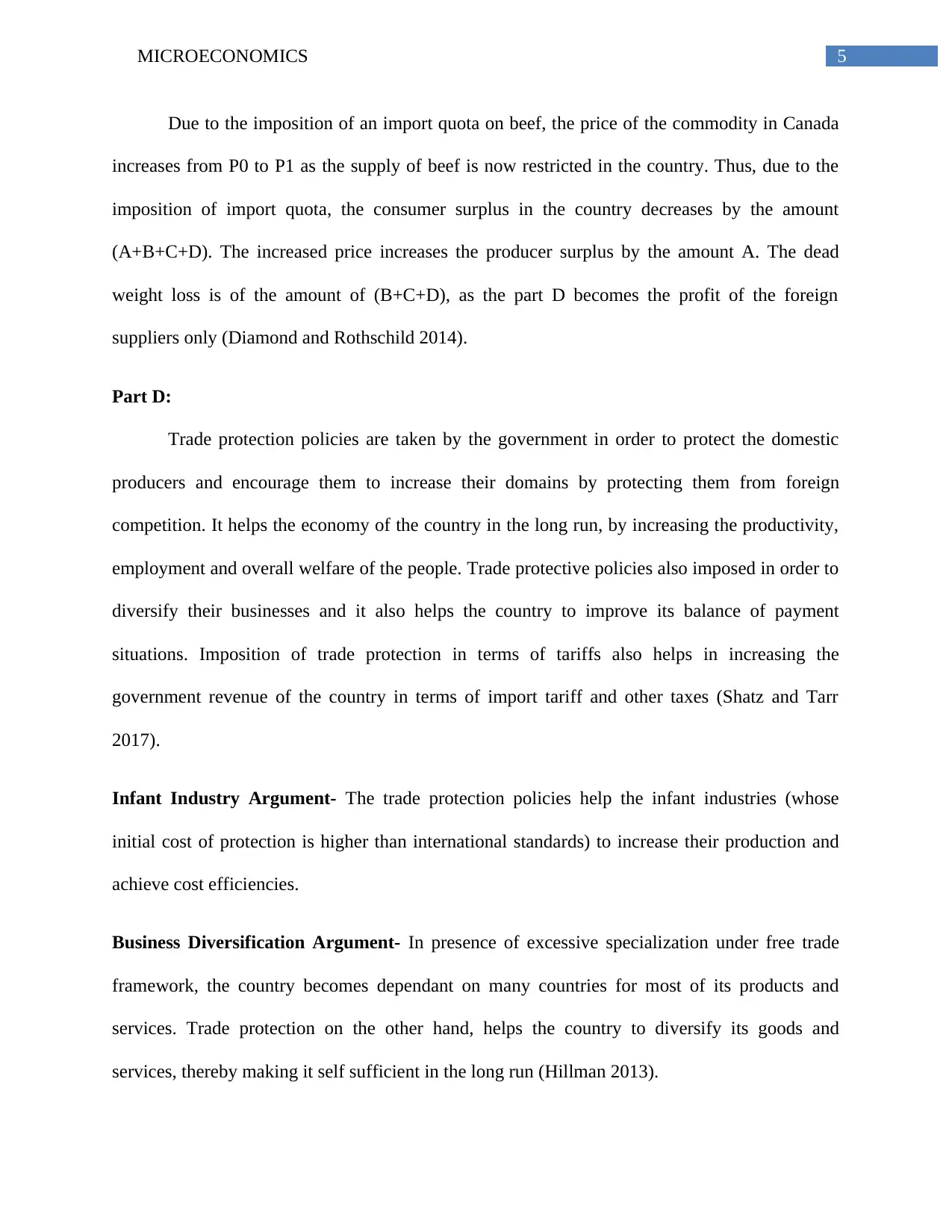
5MICROECONOMICS
Due to the imposition of an import quota on beef, the price of the commodity in Canada
increases from P0 to P1 as the supply of beef is now restricted in the country. Thus, due to the
imposition of import quota, the consumer surplus in the country decreases by the amount
(A+B+C+D). The increased price increases the producer surplus by the amount A. The dead
weight loss is of the amount of (B+C+D), as the part D becomes the profit of the foreign
suppliers only (Diamond and Rothschild 2014).
Part D:
Trade protection policies are taken by the government in order to protect the domestic
producers and encourage them to increase their domains by protecting them from foreign
competition. It helps the economy of the country in the long run, by increasing the productivity,
employment and overall welfare of the people. Trade protective policies also imposed in order to
diversify their businesses and it also helps the country to improve its balance of payment
situations. Imposition of trade protection in terms of tariffs also helps in increasing the
government revenue of the country in terms of import tariff and other taxes (Shatz and Tarr
2017).
Infant Industry Argument- The trade protection policies help the infant industries (whose
initial cost of protection is higher than international standards) to increase their production and
achieve cost efficiencies.
Business Diversification Argument- In presence of excessive specialization under free trade
framework, the country becomes dependant on many countries for most of its products and
services. Trade protection on the other hand, helps the country to diversify its goods and
services, thereby making it self sufficient in the long run (Hillman 2013).
Due to the imposition of an import quota on beef, the price of the commodity in Canada
increases from P0 to P1 as the supply of beef is now restricted in the country. Thus, due to the
imposition of import quota, the consumer surplus in the country decreases by the amount
(A+B+C+D). The increased price increases the producer surplus by the amount A. The dead
weight loss is of the amount of (B+C+D), as the part D becomes the profit of the foreign
suppliers only (Diamond and Rothschild 2014).
Part D:
Trade protection policies are taken by the government in order to protect the domestic
producers and encourage them to increase their domains by protecting them from foreign
competition. It helps the economy of the country in the long run, by increasing the productivity,
employment and overall welfare of the people. Trade protective policies also imposed in order to
diversify their businesses and it also helps the country to improve its balance of payment
situations. Imposition of trade protection in terms of tariffs also helps in increasing the
government revenue of the country in terms of import tariff and other taxes (Shatz and Tarr
2017).
Infant Industry Argument- The trade protection policies help the infant industries (whose
initial cost of protection is higher than international standards) to increase their production and
achieve cost efficiencies.
Business Diversification Argument- In presence of excessive specialization under free trade
framework, the country becomes dependant on many countries for most of its products and
services. Trade protection on the other hand, helps the country to diversify its goods and
services, thereby making it self sufficient in the long run (Hillman 2013).
⊘ This is a preview!⊘
Do you want full access?
Subscribe today to unlock all pages.

Trusted by 1+ million students worldwide

6MICROECONOMICS
Answer 4:
Part A:
The commodity Alcopops, being a commodity of addictive nature, the demand of the
same is not highly dependent on the price level of the same. People who are addicted to
Alcopops will try to buy it at any price, as the demand for the same increases with the increase in
the addiction. Therefore, the outcome of the imposition of tax on Alcopops, which was done to
reduce the demand for the same and to increase the government revenue, has not been as
expected (Rios, McConnell and Brue 2013). This is mainly because the demand for the same is
highly inelastic to the changes in the price of the same. This can be explained with the help of the
following diagram:
Figure 3: Inelastic demand and imposition of tax
(Source: As created by the author)
Answer 4:
Part A:
The commodity Alcopops, being a commodity of addictive nature, the demand of the
same is not highly dependent on the price level of the same. People who are addicted to
Alcopops will try to buy it at any price, as the demand for the same increases with the increase in
the addiction. Therefore, the outcome of the imposition of tax on Alcopops, which was done to
reduce the demand for the same and to increase the government revenue, has not been as
expected (Rios, McConnell and Brue 2013). This is mainly because the demand for the same is
highly inelastic to the changes in the price of the same. This can be explained with the help of the
following diagram:
Figure 3: Inelastic demand and imposition of tax
(Source: As created by the author)
Paraphrase This Document
Need a fresh take? Get an instant paraphrase of this document with our AI Paraphraser
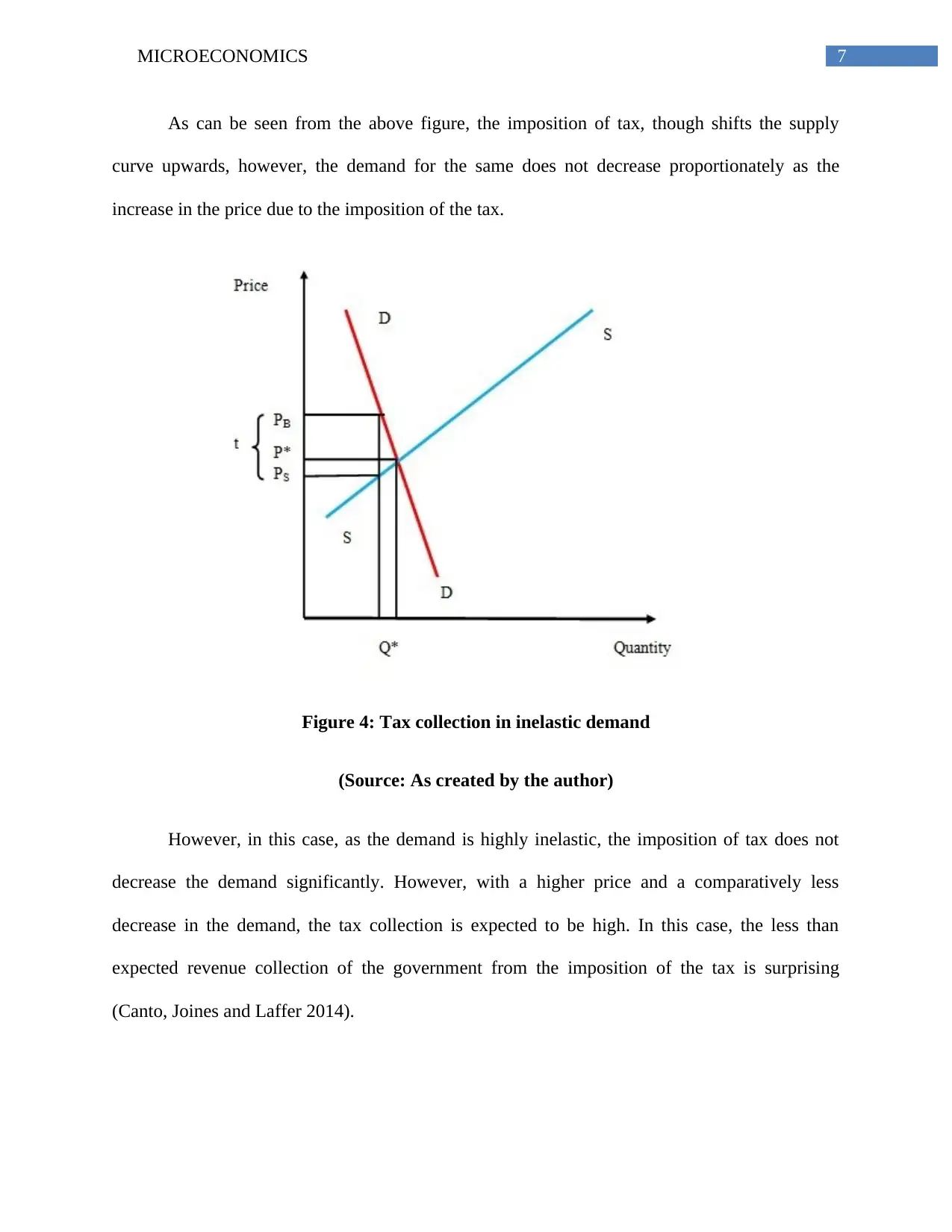
7MICROECONOMICS
As can be seen from the above figure, the imposition of tax, though shifts the supply
curve upwards, however, the demand for the same does not decrease proportionately as the
increase in the price due to the imposition of the tax.
Figure 4: Tax collection in inelastic demand
(Source: As created by the author)
However, in this case, as the demand is highly inelastic, the imposition of tax does not
decrease the demand significantly. However, with a higher price and a comparatively less
decrease in the demand, the tax collection is expected to be high. In this case, the less than
expected revenue collection of the government from the imposition of the tax is surprising
(Canto, Joines and Laffer 2014).
As can be seen from the above figure, the imposition of tax, though shifts the supply
curve upwards, however, the demand for the same does not decrease proportionately as the
increase in the price due to the imposition of the tax.
Figure 4: Tax collection in inelastic demand
(Source: As created by the author)
However, in this case, as the demand is highly inelastic, the imposition of tax does not
decrease the demand significantly. However, with a higher price and a comparatively less
decrease in the demand, the tax collection is expected to be high. In this case, the less than
expected revenue collection of the government from the imposition of the tax is surprising
(Canto, Joines and Laffer 2014).
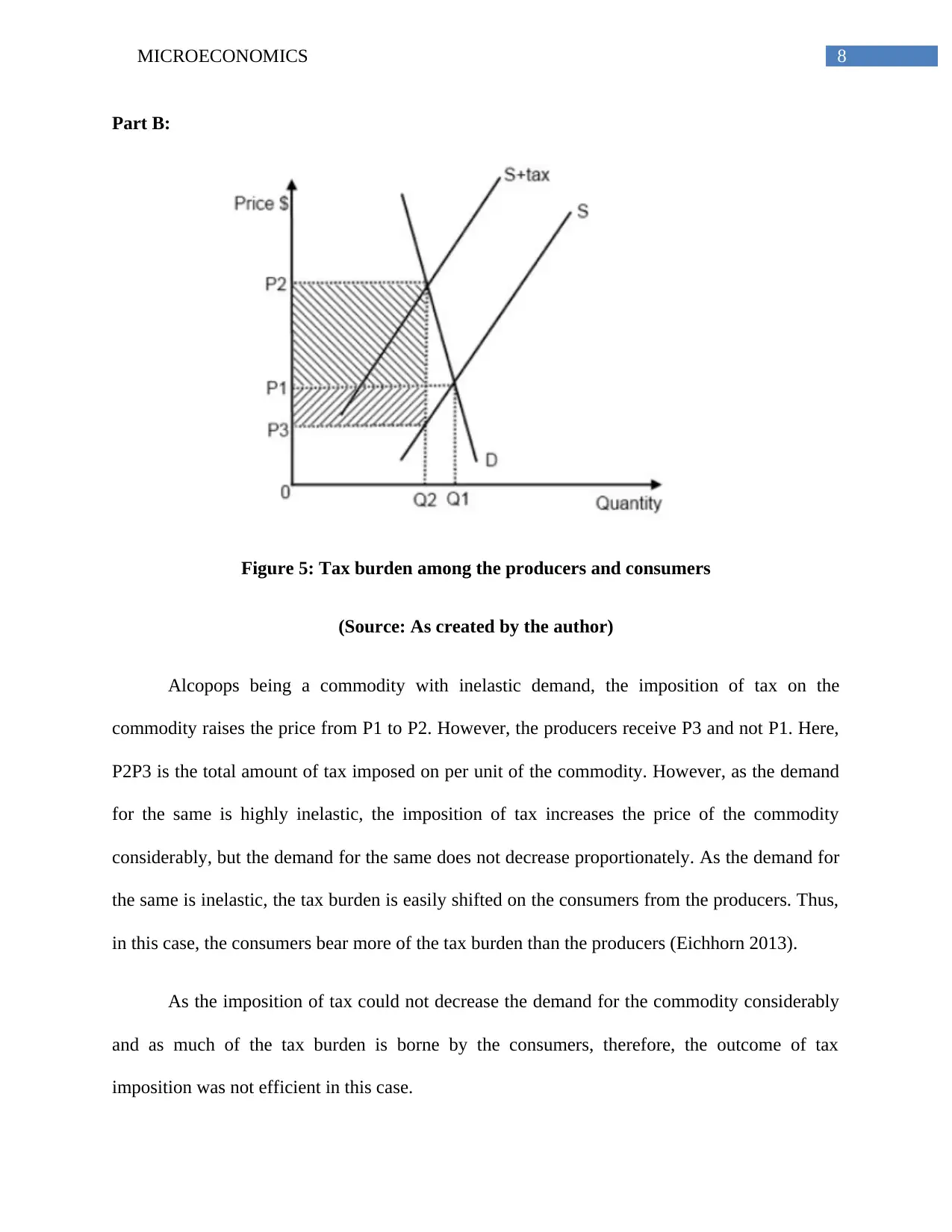
8MICROECONOMICS
Part B:
Figure 5: Tax burden among the producers and consumers
(Source: As created by the author)
Alcopops being a commodity with inelastic demand, the imposition of tax on the
commodity raises the price from P1 to P2. However, the producers receive P3 and not P1. Here,
P2P3 is the total amount of tax imposed on per unit of the commodity. However, as the demand
for the same is highly inelastic, the imposition of tax increases the price of the commodity
considerably, but the demand for the same does not decrease proportionately. As the demand for
the same is inelastic, the tax burden is easily shifted on the consumers from the producers. Thus,
in this case, the consumers bear more of the tax burden than the producers (Eichhorn 2013).
As the imposition of tax could not decrease the demand for the commodity considerably
and as much of the tax burden is borne by the consumers, therefore, the outcome of tax
imposition was not efficient in this case.
Part B:
Figure 5: Tax burden among the producers and consumers
(Source: As created by the author)
Alcopops being a commodity with inelastic demand, the imposition of tax on the
commodity raises the price from P1 to P2. However, the producers receive P3 and not P1. Here,
P2P3 is the total amount of tax imposed on per unit of the commodity. However, as the demand
for the same is highly inelastic, the imposition of tax increases the price of the commodity
considerably, but the demand for the same does not decrease proportionately. As the demand for
the same is inelastic, the tax burden is easily shifted on the consumers from the producers. Thus,
in this case, the consumers bear more of the tax burden than the producers (Eichhorn 2013).
As the imposition of tax could not decrease the demand for the commodity considerably
and as much of the tax burden is borne by the consumers, therefore, the outcome of tax
imposition was not efficient in this case.
⊘ This is a preview!⊘
Do you want full access?
Subscribe today to unlock all pages.

Trusted by 1+ million students worldwide
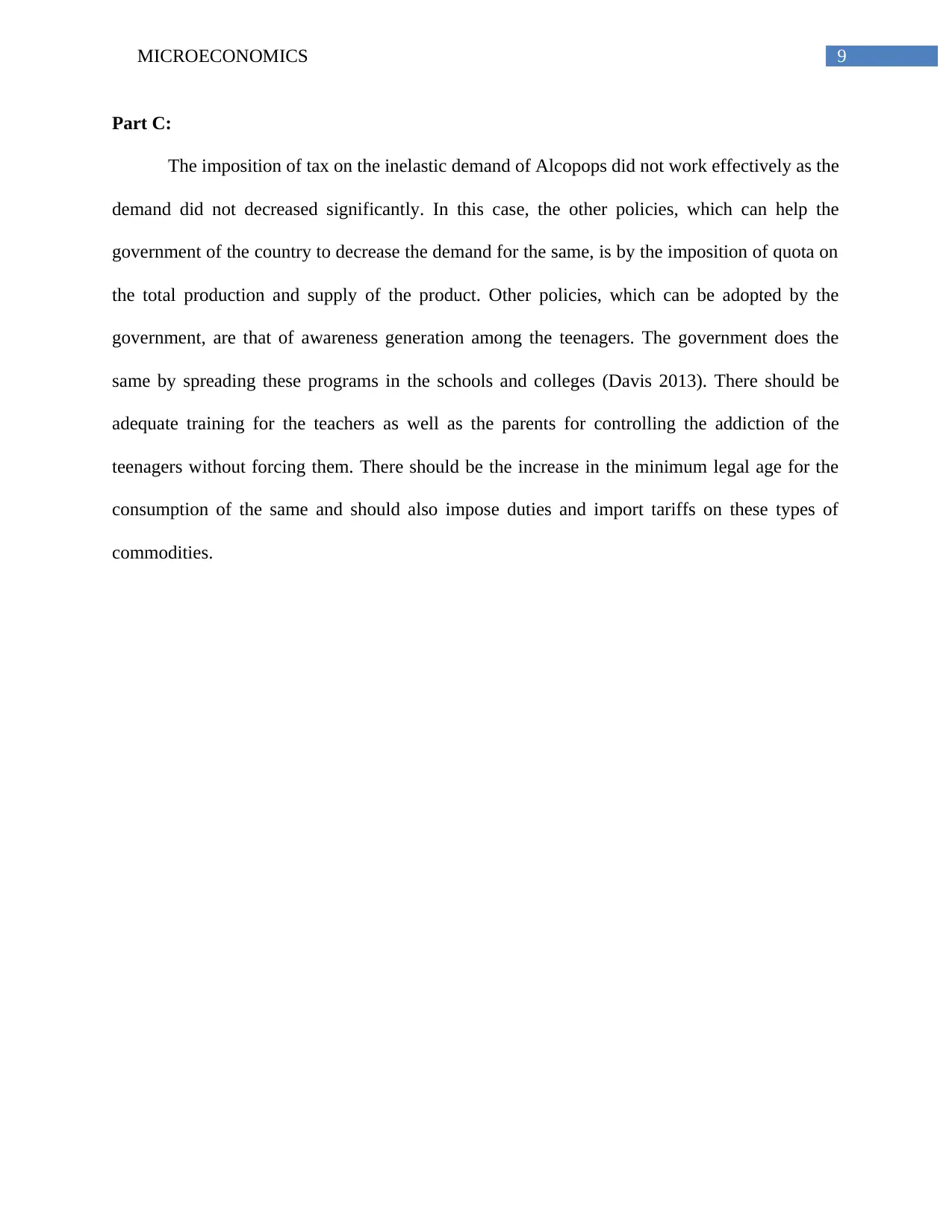
9MICROECONOMICS
Part C:
The imposition of tax on the inelastic demand of Alcopops did not work effectively as the
demand did not decreased significantly. In this case, the other policies, which can help the
government of the country to decrease the demand for the same, is by the imposition of quota on
the total production and supply of the product. Other policies, which can be adopted by the
government, are that of awareness generation among the teenagers. The government does the
same by spreading these programs in the schools and colleges (Davis 2013). There should be
adequate training for the teachers as well as the parents for controlling the addiction of the
teenagers without forcing them. There should be the increase in the minimum legal age for the
consumption of the same and should also impose duties and import tariffs on these types of
commodities.
Part C:
The imposition of tax on the inelastic demand of Alcopops did not work effectively as the
demand did not decreased significantly. In this case, the other policies, which can help the
government of the country to decrease the demand for the same, is by the imposition of quota on
the total production and supply of the product. Other policies, which can be adopted by the
government, are that of awareness generation among the teenagers. The government does the
same by spreading these programs in the schools and colleges (Davis 2013). There should be
adequate training for the teachers as well as the parents for controlling the addiction of the
teenagers without forcing them. There should be the increase in the minimum legal age for the
consumption of the same and should also impose duties and import tariffs on these types of
commodities.
Paraphrase This Document
Need a fresh take? Get an instant paraphrase of this document with our AI Paraphraser
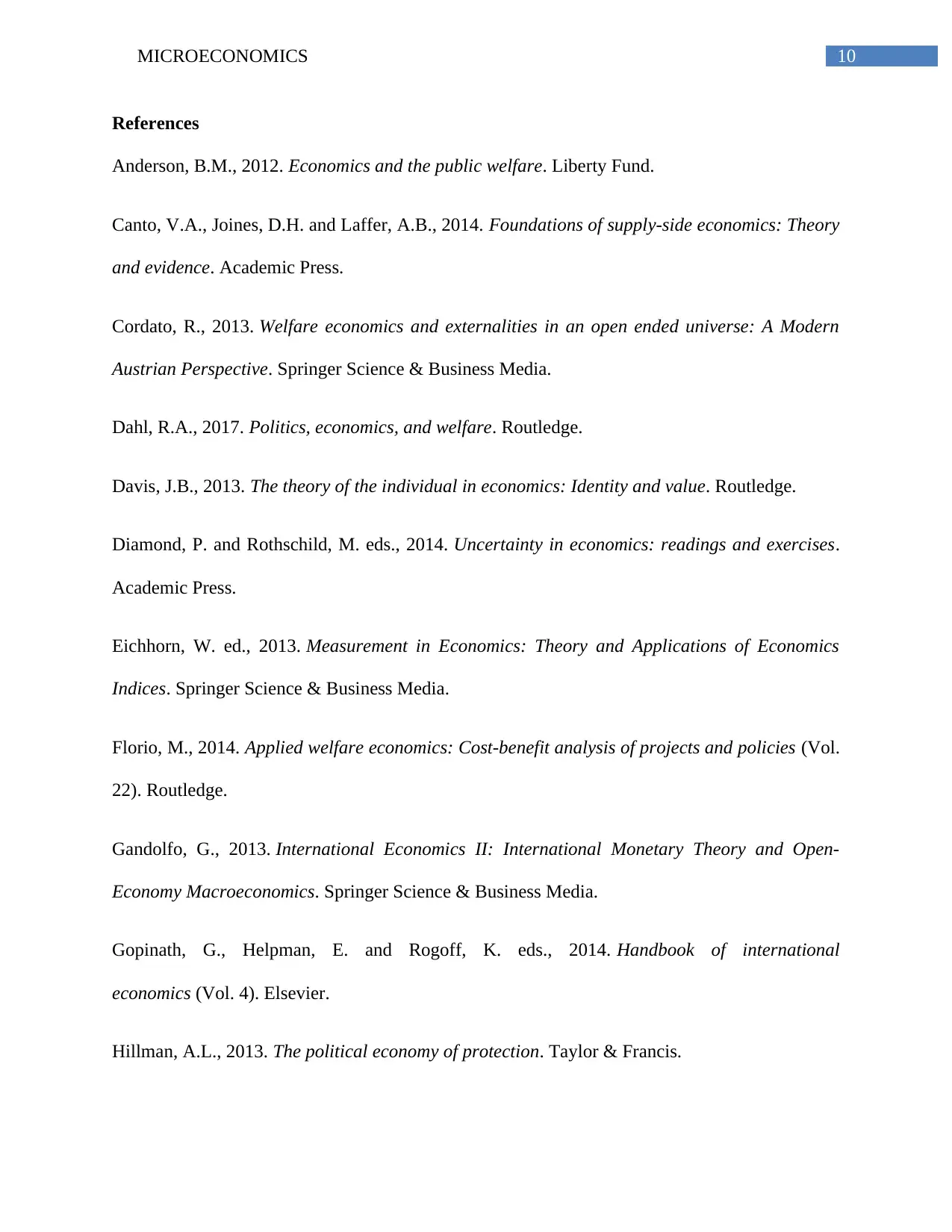
10MICROECONOMICS
References
Anderson, B.M., 2012. Economics and the public welfare. Liberty Fund.
Canto, V.A., Joines, D.H. and Laffer, A.B., 2014. Foundations of supply-side economics: Theory
and evidence. Academic Press.
Cordato, R., 2013. Welfare economics and externalities in an open ended universe: A Modern
Austrian Perspective. Springer Science & Business Media.
Dahl, R.A., 2017. Politics, economics, and welfare. Routledge.
Davis, J.B., 2013. The theory of the individual in economics: Identity and value. Routledge.
Diamond, P. and Rothschild, M. eds., 2014. Uncertainty in economics: readings and exercises.
Academic Press.
Eichhorn, W. ed., 2013. Measurement in Economics: Theory and Applications of Economics
Indices. Springer Science & Business Media.
Florio, M., 2014. Applied welfare economics: Cost-benefit analysis of projects and policies (Vol.
22). Routledge.
Gandolfo, G., 2013. International Economics II: International Monetary Theory and Open-
Economy Macroeconomics. Springer Science & Business Media.
Gopinath, G., Helpman, E. and Rogoff, K. eds., 2014. Handbook of international
economics (Vol. 4). Elsevier.
Hillman, A.L., 2013. The political economy of protection. Taylor & Francis.
References
Anderson, B.M., 2012. Economics and the public welfare. Liberty Fund.
Canto, V.A., Joines, D.H. and Laffer, A.B., 2014. Foundations of supply-side economics: Theory
and evidence. Academic Press.
Cordato, R., 2013. Welfare economics and externalities in an open ended universe: A Modern
Austrian Perspective. Springer Science & Business Media.
Dahl, R.A., 2017. Politics, economics, and welfare. Routledge.
Davis, J.B., 2013. The theory of the individual in economics: Identity and value. Routledge.
Diamond, P. and Rothschild, M. eds., 2014. Uncertainty in economics: readings and exercises.
Academic Press.
Eichhorn, W. ed., 2013. Measurement in Economics: Theory and Applications of Economics
Indices. Springer Science & Business Media.
Florio, M., 2014. Applied welfare economics: Cost-benefit analysis of projects and policies (Vol.
22). Routledge.
Gandolfo, G., 2013. International Economics II: International Monetary Theory and Open-
Economy Macroeconomics. Springer Science & Business Media.
Gopinath, G., Helpman, E. and Rogoff, K. eds., 2014. Handbook of international
economics (Vol. 4). Elsevier.
Hillman, A.L., 2013. The political economy of protection. Taylor & Francis.
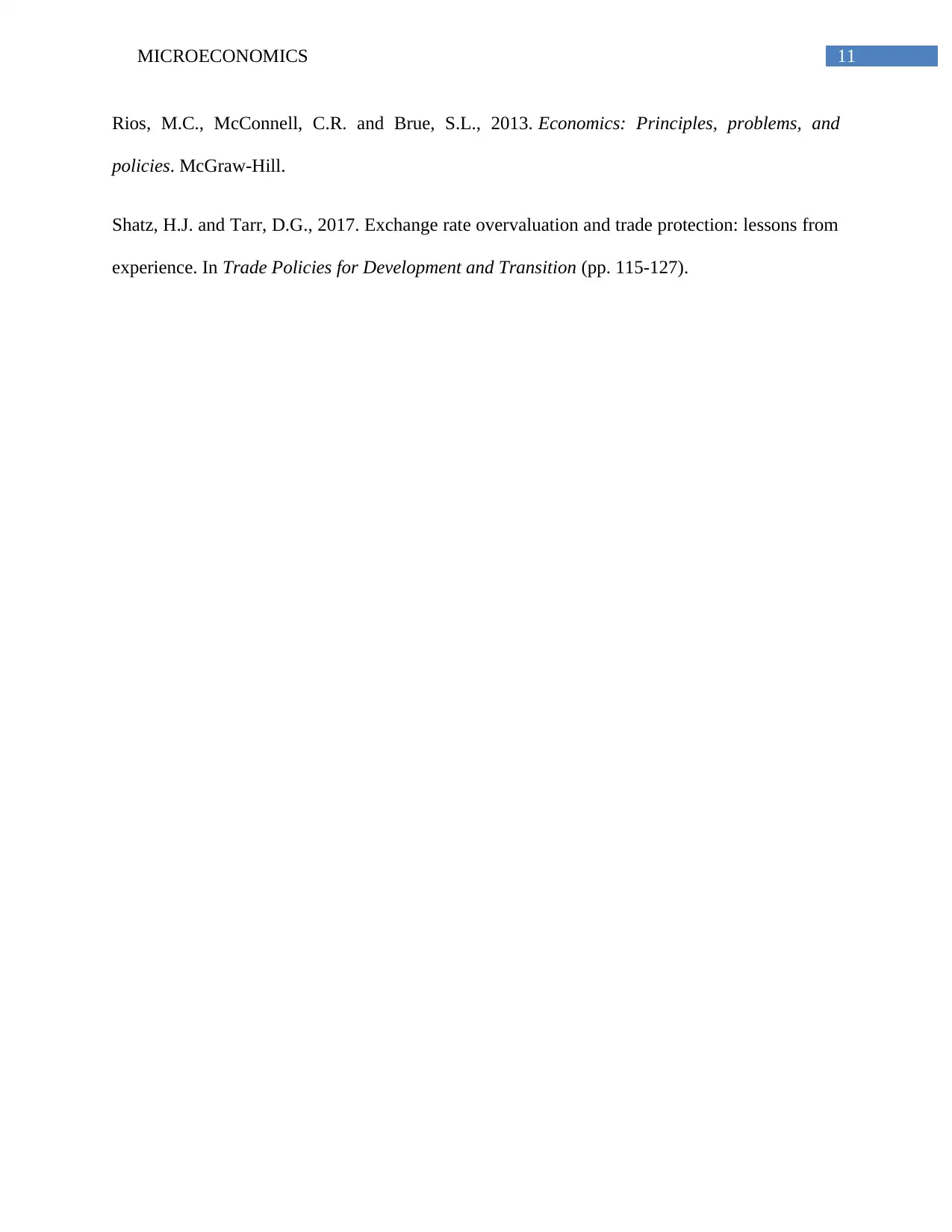
11MICROECONOMICS
Rios, M.C., McConnell, C.R. and Brue, S.L., 2013. Economics: Principles, problems, and
policies. McGraw-Hill.
Shatz, H.J. and Tarr, D.G., 2017. Exchange rate overvaluation and trade protection: lessons from
experience. In Trade Policies for Development and Transition (pp. 115-127).
Rios, M.C., McConnell, C.R. and Brue, S.L., 2013. Economics: Principles, problems, and
policies. McGraw-Hill.
Shatz, H.J. and Tarr, D.G., 2017. Exchange rate overvaluation and trade protection: lessons from
experience. In Trade Policies for Development and Transition (pp. 115-127).
⊘ This is a preview!⊘
Do you want full access?
Subscribe today to unlock all pages.

Trusted by 1+ million students worldwide
1 out of 12
Related Documents
Your All-in-One AI-Powered Toolkit for Academic Success.
+13062052269
info@desklib.com
Available 24*7 on WhatsApp / Email
![[object Object]](/_next/static/media/star-bottom.7253800d.svg)
Unlock your academic potential
Copyright © 2020–2025 A2Z Services. All Rights Reserved. Developed and managed by ZUCOL.





